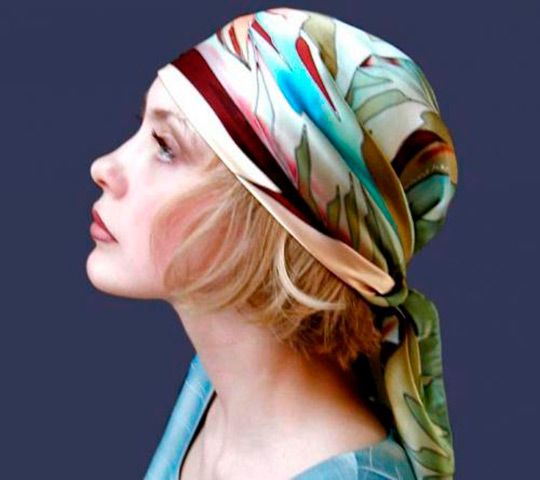At all times, starting from the period of ancient civilizations, it was customary for women to cover their heads. Our primitive ancestors used a large scarf for this, which, in addition to hair, covered the chest and neck. It was replaced by a scarf - an oblique piece of fabric in the shape of an isosceles triangle.

In some countries, a tradition has still been preserved: after the wedding ceremony, remove the veil from the young wife and put on a headscarf. If grief happened in the family, then during the period of mourning the women always wore a black laboring scarf, the name of which comes from the verb “to grieve,” that is, to grieve. This tradition has been preserved in Rus' to this day.
Orthodox believers in post-Soviet countries still practice the custom of wearing a headscarf in churches, temples and all religious events.
In the Soviet Union, the color red became the symbol of the October Revolution, so Bolshevik women began to wear scarlet headscarves. Komsomol women of the 20s and 30s of the 20th century wore not only a similar headdress, but also a bright tie.
In Medieval Europe, during the period of persecution of glamorous women by the Holy Inquisition, it was customary to hide the head under a headscarf: open hair was considered a sinful element of seducing men.

@fi.pinterest.com
In the United States of America in the 20s of the last century, so-called rural country music, very common in the south and west of the country, was gaining popularity. One of the main elements of the subculture under consideration is the bandana - a silk or textile scarf tied at the back of the head. This item of clothing is worn by men and women of different generations and social classes.
The traditional outfit of French young ladies of the mid-18th century was a set of a skirt, jacket, piquant hat and... headscarf. The latter was intended to hide the neck and chest, but temperamental French women often took it off, citing the heat.
Spanish girls rarely wear a headscarf in our traditional sense of this element of clothing, but a long scarf, a mantilla, tied at the back, was popular among them. Later it was replaced by a short scarf - toquilla, which Spanish Catholic women still wear to church to this day.
In Japan, the tradition of wearing a snow-white headscarf for the bride has long been observed. The wedding ritual in the Land of the Rising Sun is of great importance. The bride wears a classic kimono, and her high hairstyle is always decorated with a white scarf.

@pinterest.com.au
The headscarf is part of the national costume of gypsy women. The tradition of covering hair appeared in the middle of the 19th century, when nomadic people settled in western Europe. To this day, married gypsy women weave tight braids, which they hide from prying eyes. Young girls also wear this attribute, but they cover their braids in a bun.In fact, among gypsies, like among the ancient Slavs, hair is a magical attribute. This is why girls used to not be able to cut their locks short. It was believed that they were losing their feminine strength and essence. The hair was always covered, because it protected the girl from evil eyes.
Nowadays, a headscarf is a stylish and fashionable accessory for a modern lady. This wardrobe item is made from a wide variety of fabrics, from cotton and silk to winter options made of cashmere and fur.